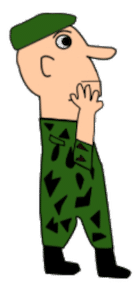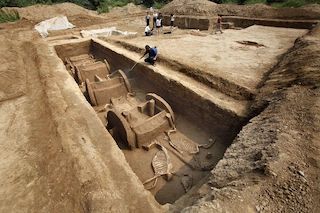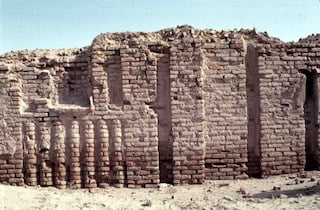 I think that’s pretty cool the way they taught themselves how to write and communicate and all that. Sense they’re smart enough to do that one would think they would be smart enough to be right with You.
I think that’s pretty cool the way they taught themselves how to write and communicate and all that. Sense they’re smart enough to do that one would think they would be smart enough to be right with You.
1 Woe to them that go down to Egypt for help; and stay on horses, and trust in chariots, because they are many; and in horsemen, because they are very strong; but they look not unto the Holy One of Israel, neither seek the LORD!

It could have been as early as 700 years before the birth of Jesus Christ that these horses were moved on to greener pastures – and no one has laid eyes on them until now. Archaeologists have painstakingly uncovered the almost 3,000-year-old remains of horses and wooden chariots in a Zhou Dynasty tomb in Luoyang, Henan Province, China. The completed excavation unearthed four horse-and-chariot pits, dating back as far as 770BC.
The pits have well-preserved evidence of bronzeware and ceramics from the Early Western Zhou dynasty. Though a far smaller tomb than the famous ‘terracotta army’ found in 1974 in the Lintong District, this find has been undisturbed while buried and has not suffered the ravages of grave robbers.
Archaeologists believe that the tomb belongs to an official of some renown during the dynasty – pottery, metal weaponry and inscriptions are consistent with a man of mid-level importance. Apart from the artifacts themselves, the tomb is an exciting discovery for historians, as it provides unquestionable insights into funeral customs in the early Western Zhou dynasty.
The unearthed tomb is a vertical earthen pit tomb, which is very common in that period. Because of the age of the site, the traditionally wooden coffin and body within have long-since carbonised. But the most valuable discovery by far is the complete set of chariots and horses, of all shapes and sizes.
Animal lovers can breathe a small sigh of relief – archaeologists say the position of the horses, lying on their sides, show that the animals were slaughtered before burial, and not entombed alive.
At the time of this official”s death, large-scale irrigation projects were being instituted across China, and the nation’s writing system was being further developed. It was also the time of the great Chinese philosophers of antiquity, including Confucius, Mencius, and Zhuangzi. Many nearby tombs have fragments similar to the Luoyang find, but most have been emptied of their funeral relics by thieves.
See 30:1 and note. Ch 31 recapitulates ch 30.
“Horses…chariots” – Egypt had large numbers of horses and chariots (see Kgs 10:28-29).
2 Yet he also is wise, and will bring evil, and will not call back his words: but will arise against the house of the evildoers, and against the help of them that work iniquity.
“He also is wise” – people had questioned God’s wisdom in 29:14-16.
3 Now the Egyptians are men, and not God; and their horses flesh, and not spirit. When the LORD shall stretch out his hand, both he that helpeth shall fall, and he that is holpen shall fall down, and they all shall fail together.
“Stretch out his hand” – cf the refrain in 5:25; 9:12, 12, 21, 10:4.
“He that is hopen” – or “the one who is helped” (Israel).
“Shall fall” – Israel will fall in spite of Egypt’s help (cf 30:3, 5).
4 For thus hath the LORD spoken unto me, Like as the lion and the young lion roaring on his prey, when a multitude of shepherds is called forth against him, he will not be afraid of their voice, nor abase himself for the noise of them: so shall the LORD of hosts come down to fight for mount Zion, and for the hill thereof.
“Lion” – a simile, but perhaps also an allusion to the Assyrian king (see note on 15:9).
“Shepherds” – perhaps an allusion to the rulers of the nations (see Nah 3:18).
5 As birds flying, so will the LORD of hosts defend Jerusalem; defending also he will deliver it; and passing over he will preserve it.
“Birds…defend” – cf Deut 32:10-11.
“Passing over” – the technical word used of the destroying angel who “:passed over” every house in Egypt that had blood on the door posts (see Ex 12:13, 23; cf Isa 37;35).
6 Turn ye unto him from whom the children of Israel have deeply revolted.
7 For in that day every man shall cast away his idols of silver, and his idols of gold, which your own hands have made unto you for a sin.
8 Then shall the Assyrian fall with the sword, not of a mighty man; and the sword, not of a mean man, shall devour him: but he shall flee from the sword, and his young men shall be discomfited.
“Sword, not a mighty man” – the angel of the Lord struck down 185,000 soldiers (see 37:36).
“Shall be discomfited” – Lit. “shall become slave laborers” (as prisoners of war).
9 And he shall pass over to his strong hold for fear, and his princes shall be afraid of the ensign, saith the LORD, whose fire is in Zion, and his furnace in Jerusalem.
“Pass over…fear” – the Assyrian king will retreat out of fear but will still not avoid God’s judgment. Nineveh was destroyed by the Medes and Babylonians in 612 B.C. (see Nah 3:7).

Neo-Babylonian, 594 B.C.
The Babylonian cuneiform inscription on this clay tablet sheds new light on Chapter 39 of the Biblical Book of Jeremiah.
It gives the name and title of a high-ranking Babylonian officer who, according to Jeremiah, was present at the historic siege of Jerusalem in 587 BC with King Nebuchadnezzar II. It therefore confirms the historical existence of this Biblical figure.
“Princes shall be afraid” – cf Nah 2:10.
“fire…furnace” – the Lord’s glory resides in Zion, and from that center of His people His fire of judgment breaks out upon the wicked (see 10:17, 30:33, cf Lev 10:2; Joel 3:16; Amos 1:2).
The devil tricked all these people just like he did the Catholics. The Catholics are pretty sneaky, the way they slither around like a snake and do evil things. Makes me think about the One World Order that has been on the table for decades. I’m going to do some research on that.
But anyway, didn’t Jesus say something about us not being able to play both fields?
“Ye cannot drink the cup of the Lord, and the cup of devils: ye cannot be partakers of the Lord’s table, and of the table of devils” (1 Cor 10:21).
Cuneiform and Clay Tablets
In the Ancient Near East
In ancient Mesopotamia the most commonly used writing material was the clay tablet (cf Isa 30:8). The earliest ones were produced at the Sumerian city of Uruk during the 4th millennium B.C.

Clay was available in such abundance and was so easy to mold into writing tablets that there was no obstacle to producing a great quantity of such tablets. Thus, over a half million tablet-documents have been discovered to date from the ancient Near East.
Writing first involved carving into the clay with a sharp stick or nail – described as “nail-writing.” No one knows exactly how writing emerged, but it probably began with clay tokens that were used as record-keeping devices. Marks placed upon these tokens eventually evolved into writing.
At first “nail-writing” was practiced by drawing pictures and pictographic symbols, e.g., a depiction of a man to represent a man. Today we use pictograms to communicate simple ideas.
A stylized likeness of a man or woman can represent the men’s or women’s restroom; a cigarette with a circle around it and slash mark over it has come to be understood as “No Smoking.” But it’s impossible to communicate complex speech with such symbols.
As the need for record keeping increased, pictograms became more abstract and began to be formed with quick, straight strokes instead of curving lines (the picture of the man became more stylized and abstract – a symbol rather than a recognizable picture).
By the 3rd millennium B.C. cuneiform had been invent ted. Cuneiform (Latin for “wedge-shaped”) is so named for the shape of the mark made by a reed stylus, triangular at one end, that was pressed into wet clay to make wedge-shaped lines.
With the advent of cuneiform, writing became even more abstract. Signs could now represent not only words but also syllables, several of which could be combined to represent the syllables of a word.
For example, the Sumerian word for “barley” is she. In cuneiform, the sign for barley might literally mean “barley,” but it might also denote some other word with the syllable she in it.
Using English for our analogy, in this system the symbol for “man” might represent a man, but it might also represent the syllable “man-“ in “manner” or “manufacture.” As the system became more sophisticated and uniform, the number of signs needed for writing was reduced.
Whereas many as 2,000 signs are known from the earliest tables, there were only about 200 still in use by the 2nd millennium B.C. This allowed writing to truly represent speech, with all of its complexities of vocabulary and grammar. Thus, myths, legends, history and songs began to be recorded.
Another development was the linear arrangement of signs. Originally, tablets were divided into rectangular boxes into which related signs were drawn in no particular order. These boxes were arranged in vertical columns.

As writing became more abstract and rapid (c. 2500 B.C.), the signs within the boxes came to be written from left to right. Later the boxes were no longer drawn, and the signs were written left to right across the face of the tablet. This also led to a standardization of sign height, much as one finds today in ruled paper.
Cuneiform was first developed for use with the Sumerian language was adapted for other Mesopotamian languages. The Akkadians adopted this form of writing, and as their realm of influence grew, cuneiform writing spread.
By the 2nd millennium B.C. the Elamites, Hurrians, and Hittites were employing cuneiform to write their own languages. Eventually Akkadian became the international language of diplomacy and Akkadian cuneiform spread throughout the Near East.
The Amarna Letters demonstrate that cuneiform was utilized in 14th century B.C. Canaan and was readable in the Egyptian royal court.
Around 1600 B.C. the Phoenicians invented the precursor to the modern alphabet. in a true alphabet signs represent not words or syllables but individual consonants and vowels.
This allows for writing to use a very small number of signs. With an alphabet there are fewer signs to learn, allowing almost anyone to become literate. Also, spelling becomes more accurate and uniform, resulting in less ambiguity and confusion.
The efficiency of the alphabet eventually led to the decline of cuneiform in Syria-Palestine. The Aramaic language (due to the Hebrew Bible, most scholars say this is what Jesus spoke), which was written alphabetically, replaced Akkadian as the lingua franca (language of common, commercial) of the ancient Near East world.
Visits: 0
